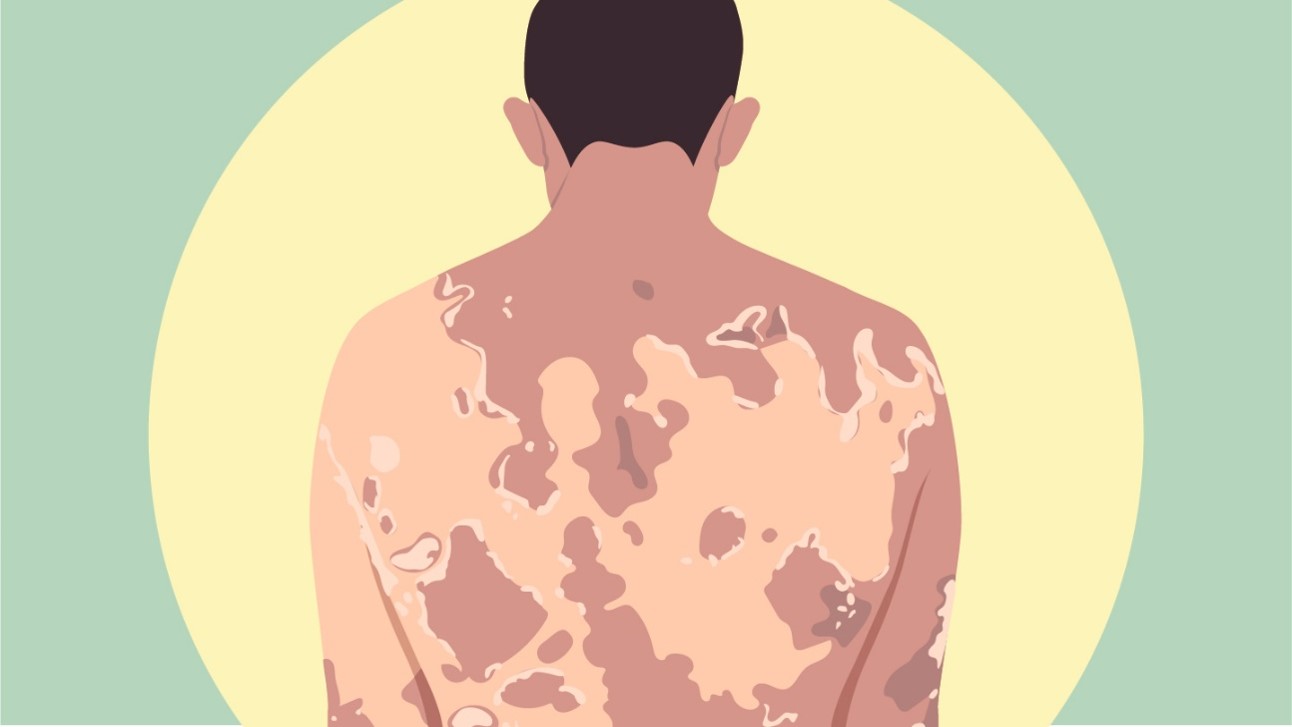Netherton syndrome (NS)
Netherton syndrome (NS) is a severe, ultra-rare multisystem disorder which has a life-altering impact across a person’s life.1

Symptoms of Netherton syndrome:
NS is classified as an autosomal recessive congenital ichthyosis (ARCI).2 It is caused by a mutation in the SPINK5 gene, resulting in a loss of skin barrier function and excess immune system activation1,3
In addition to symptoms affecting the skin it also can cause non-skin manifestations and these symptoms can differ between people living with NS.1 NS symptoms can appear from birth and may continue into adulthood.4
The key symptoms affecting the skin are:1,4,5
- Scaling including circular scaly rashes and peeling
- Erythema/redness
- Persistent itch
- Pain
- Thin, fragile hair (bamboo hair), hair loss and other abnormalities
As a multisystemic condition, the impact of NS goes beyond the skin. The non-skin related symptoms of NS include:1,4,5
- Immune related problems such as asthma, rhinitis, conjunctivitis, angioedema and food allergies
- Recurrent infections and sepsis
- Sleep disorders
- Severe impact on organs resulting in Rickets, pancreatitis and esophagitis
What causes Netherton syndrome:
NS is caused by a mutation in the SPINK5 gene, inherited from each parent, which plays an important role in everyday skin renewal.1,3 A mutation in this gene leads to the loss of skin barrier function and excess immune system activation.1,3.

NS is estimated to affect 1 to 9 people per million in the population.6 However, the prevalence of NS may be underestimated because of early mortality in newborns and difficulty in its diagnosis due to symptoms often resembling those of other conditions.5,7
Diagnosing NS is often challenging as it is very rare, symptoms can change over time and can differ between people living with NS.1
NS in newborns can be life-threatening because of severe water loss and the risk of infections.8,9 Prognosis is poor due to high mortality in the first years of life, with mortality rates ranging from 10% to 20%.10,11 Infants with this condition tend to grow slowly and have poor weight gain.4
How Netherton syndrome affects the quality of life of people living with the condition:
NS has a significant impact on quality of life.12 People may experience extreme tiredness and pain, sleeping problems, financial burden due to fewer career opportunities, and compromised performance in school.12 They may also have emotional problems, including anxiety, and depression.12
Current treatment strategies leave patients of all ages with considerable unmet needs, highlighting the importance of new and improved management options for NS.5,13
IL-36 signaling appears to be a key driver in NS with abnormal IL-36 signatures seen in both lesion skin and blood in people with NS. An increased expression of IL-36 in NS correlates with disease severity 14,15
Boehringer Ingelheim is investigating the IL-36 receptor (IL-36R) inhibitor spesolimab for the treatment of NS.16
You can find a link to the clinical study to test whether Boehringer Ingelheim’s IL-36R inhibitor spesolimab helps people with NS here.
References:
- Dyer JA. UpToDate. 2021.
- Oji V, et al. J Am Acad Dermatol. 2010;63:607–641.
- Netherton syndrome: A patient’s perspective. https://www.firstskinfoundation.org/types-of-ichthyosis/netherton-syndrome (Accessed September 2023).
- Netherton syndrome. https://rarediseases.info.nih.gov/diseases/7182/netherton-syndrome (Accessed September 2023).
- Petrova E & Hovnanian A. Expert Opin Orphan Drugs. 2020;8:455-487.
- Orpha.Net. Netherton syndrome. https://www.orpha.net/consor/cgi-bin/Disease_Search.php (Accessed September 2023).
- Moltrasio C, et al. Genes (Basel). 2023;14:1080.
- Hovnanian A. Expert Rev Dermatol. 2012;7:81-92.
- Chiticariu E & Hohl D. J Invest Dermatol. 2020;140:1129-1130.
- Qasim W. Mol Ther. 2010;18:s61.
- Renner ED, et al. J Allergy Clin Immunol. 2009;124:536-543.
- Versteegh JJ, et al. J Health Psychol. 2020;25:2296-2316.
- DermNet NZ. https://dermnetnz.org/topics/netherton-syndrome (Accessed September 2023).
- Barbieux C, et al. J Allergy Clin Immunol. 2021;149:1358-1372.
- Malik K, et al. J Allergy Clin Immunol. 2019;143(2):604–618.
- ClinicalTrials.gov. https://www.clinicaltrials.gov/ct2/show/NCT05856526 (Accessed September 2023).

What is Netherton Syndrome?

Unmet needs in Netherton syndrome
Related Content


